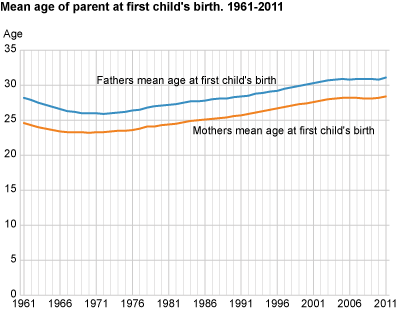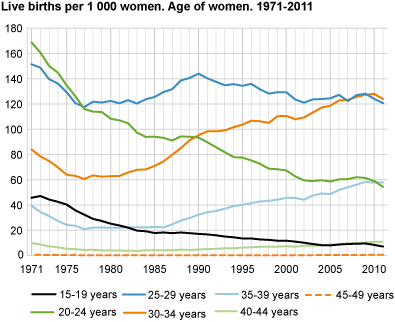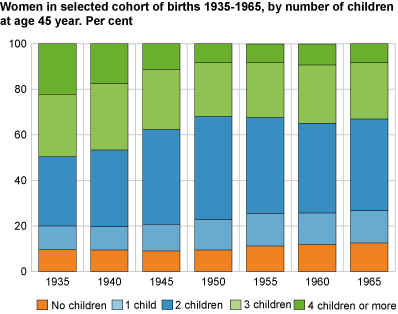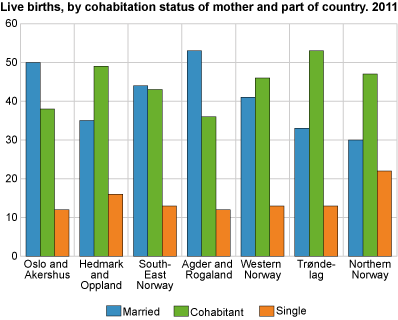Content
Published:
This is an archived release.
Fewer births and older first-time parents
A total of 60 200 children were born in Norway in 2011, which is 1 200 fewer than the year before. The mean age at the first child’s birth was 28.4 years for mothers and 31.1 years for fathers. This is 0.3 and 0.2 years above the mean age at the first child’s birth from 2006-2010.
Women aged 30-34 had the highest fertility rate in 2011, followed by women aged 25-29. Women aged 35-39 have barely half the fertility of women aged 30-34, and for the first time they have a higher fertility rate than women aged 20-24. The fertility rate for women under 35 years of age was lower than the year before, while for women aged 35 years or older it was nearly unchanged.
Total fertility decreased - to 1.88
After three years with a total fertility rate between 1.95 and 1.98 - the highest since 1975 - the total fertility rate decreased to 1.88 in 2011. The fertility rate decreased in all counties, except Møre og Romsdal, Vestfold and Nordland. In south-east Norway, as in the last 10 years, it was only the county of Akershus that had a fertility rate higher than the mean rate of the whole country. All other counties had fertility higher than the mean rate of the whole country, except the counties of Troms and Sør-Trøndelag. The counties of Sogn og Fjordane and Rogaland had a fertility rate of 2.09 and 2.07 respectively in 2011, and were the only two counties with a fertility rate high enough to ensure the reproduction of the population, i.e. where enough children are born to ensure that the population will not decrease in the long run, excluding migration.
The total fertility rate for men was 1.70 in 2011, compared to 1.75 the year before.
Total fertility rateThe total fertility rate (TFR) for women describes the average number of babies born alive per woman in the course of her reproductive period (15-49 years), under the presumption that the fertility pattern of the period lasts, and that deaths do not occur. The total fertility rate for men (TFR) is calculated for the age group 15-54 years. |
20 per cent of today’s 50 year-old men are childless
Women are having fewer children nowadays than earlier. Among women born in 1935, 22.2 per cent gave birth to four or more children. Among women aged 45 years of age today, only 8.4 per cent have given birth to at least four children. Among women born in 1935, 9.6 per cent were childless, while among women aged 45 years of age today, 12.2 per cent are childless. Increasing numbers of men are becoming fathers after 40, while the share that is childless is increasing more than among women. For men born in 1970, 13.6 per cent are childless and among men aged 50 years today, 20.3 per cent are childless.
Most single mothers in Northern Norway
A total of 44.0 per cent of the children born in 2011 had married parents, 42.5 per cent had cohabitating parents and 13.5 per cent had a single mother. In the country as a whole, there were most cohabitating parents in Trøndelag, with 53 per cent. There were most married parents in Agder and Rogaland, also with 53 per cent. Northern Norway had most single mothers, with 22 per cent.
Fewer multiple births
In 2011, there were 973 twin births and 14 triple births, which corresponds to 16.6 multiple births per 1 000 births. In 1986, the corresponding figure was 10.2. This figure subsequently increased until 2002, when it reached a peak of 19.4 multiple births per 1 000 births. Since 2002, the number of multiple births has fallen somewhat.
Tables:
- Table 1 Live births and late foetal deaths. 1951-2011
- Table 2 Confinements of single and multiple births, by sex. 1991-2011
- Table 3 Age-specific fertility rates and total fertility rate, women. 1961-2011
- Table 4 Average age of parent at child's birth. 1946-2011
- Table 5 Total fertility rate, women, by county. 1968-2011
- Table 6 Age-specific fertility rates and total fertility rate, men. 2000-2011
- Table 7 Live births, by parity. 1978-2011
- Table 8 Live births, by parity, cohabitation status of mother and county. 2011
- Table 9 Number of children distributed, by age and cohort . Per cent
Contact
-
Statistics Norway's Information Centre
E-mail: informasjon@ssb.no
tel.: (+47) 21 09 46 42
-
Espen Andersen
E-mail: espen.andersen@ssb.no
tel.: (+47) 92 61 00 46
-
Ane Margrete Tømmerås
E-mail: ane.tommeras@ssb.no
tel.: (+47) 91 99 29 62
-
Oppdrag befolkningsstatistikk
E-mail: befolkning@ssb.no




